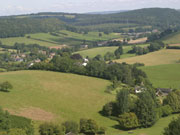 |
 |
 |
 |
This is an extract from the Weston-under-Penyard Church Monthly Magazine 1921, thanks to Gerry Lowth who passed it on to Weston News!
These notes are taken from the Woolhope records. The vicinity of "the Porch" to the old site of Ariconium suggests its derivation from 'Porta' (a gate in Latin). The Porch is not far from the northern gate of the town.
The curious word Phocle - a district also close to Ariconium, suggests as its derivation the Latin word 'Focus' (a hearth) - the place where the iron was worked. This is an alternative derivation to folk - lea. The origin of place names is most interesting, but often very uncertain. For instance Bollitree is rather a teaser!
This Roman station was second only in importance to Magna in Herefordshire. It is mentioned in the thirteenth iter [Itinerary] of Antonine, and is there stated to be fifteen miles from Glevam (Gloucester) and twelve from Blestune (Monmouth). It possessed extensive smelting furnaces and forges, as shown by the many floors discovered, and the abundance of iron scorial to be found there. It may be called Merthyr Tydvill of the Romans, and was probably also the centre of the numerous ironworks whose remains are discovered in South Herefordshire and the adjoining districts. Its very site was unknown until the beginning of the 19th century, when the celebrated antiquary, John Horsley (died 1731) in his work Brittania Romania, was the first to determine that Ariconium must have stood somewhere near Ross.
It is now proved beyond doubt to have been seated at Bollitree in the parish of Weston-under-Penyard. Up to the middle of the 18th century an extensive thicket of briars and brushwood covered and hid from view the broken walls and rubbish of Ariconium. Towards the end of that century, Mr Meyrick the proprietor of the estate, determined to stub up the bushes and clear the grounds. At that time there were portions of the walls of houses standing above ground, and quantities of antiquities of all sorts were found, vaulted chambers, sometimes containing wheat black as if charred by fire; tesselated+ pavements, bronze statuaries, fragments of pottery and cones with scorial, cinders and ashes in abundance.
In Britton and Brayley's "Beauties of England and Wales" (v. vi, p.514), it is stated that there was found there "an immense quantity of Roman coins and some British".
Among the antiquities were fibulae*, lares++, lachimatories**, lamps, rings and fragments of tessellated pavements, some pillars were also discovered, with stones having holes for the jambs of the doors, and a vault or two in which was earth of a black colour and in a curious state ……… "Innumerable pieces of grey and red pottery lie scattered over the whole tract (1805) some of them patterns by no means inelegant ……….. some of the large stones found among the ruins of the station, and which appear to have been used in building, display strong marks of fire. During the course of last summer (1804) in worming a road that crosses the land, several skeletons were found, and also a stone wall, apparently the front of a building, the stones were well worked and of considerable size." The same writer also states that the "coins which were chiefly of the lower Empire, were of gold, silver, and copper."
The British Archaeological Society visited the site in 1870 (see Journal, Vol. xxviii, pp. 203-218). The coins then exhibited by Mr Palmer consisted of one gold, six silver, and two copper British coins, some of them of Cunobelin [King of Catuvellaum AD10-42; died before Romans arrived]; one hundred and eighteen silver, billon^, and brass Roman coins, ranging from Claudius, AD 41, to Magnentius AD 350-3, twenty fibulae of bronze, a silver ring, six bronze rings, bronze keys, pins and nail, four intaglio^^ two of them (cornelian), glass beads of various colours, bronze buckles, and other bronze instruments.
| + | Tesselated = chequered or mosiac using stone/glass |
| * | Fibulae = brooches |
| ++ | Lares = Roman deities |
| ** | Lachimatories (or lachrymatories) = tear-shaped, narrow-necked bottles |
| ^ | Billon = an alloy of gold/silver with higher proportion of other metals |
| ^^ | Intagli (Intaglio) = figure or design carved in metal or stone |